SELF DOUBTS OF A RELENTLESS PERFECTIONIST
The similarity in the approaches to landscape taken by the geographer and the landscape painter have been acknowledged since the first half of the nineteenth century. Both are committed to developing coherent descriptions of he surface of the earth in that they are concerned with associations of phenomena rather than with individual features in the landscape. Ends, aesthetic in one case and scientific in the other, rather than means, distinguish their pursuits.
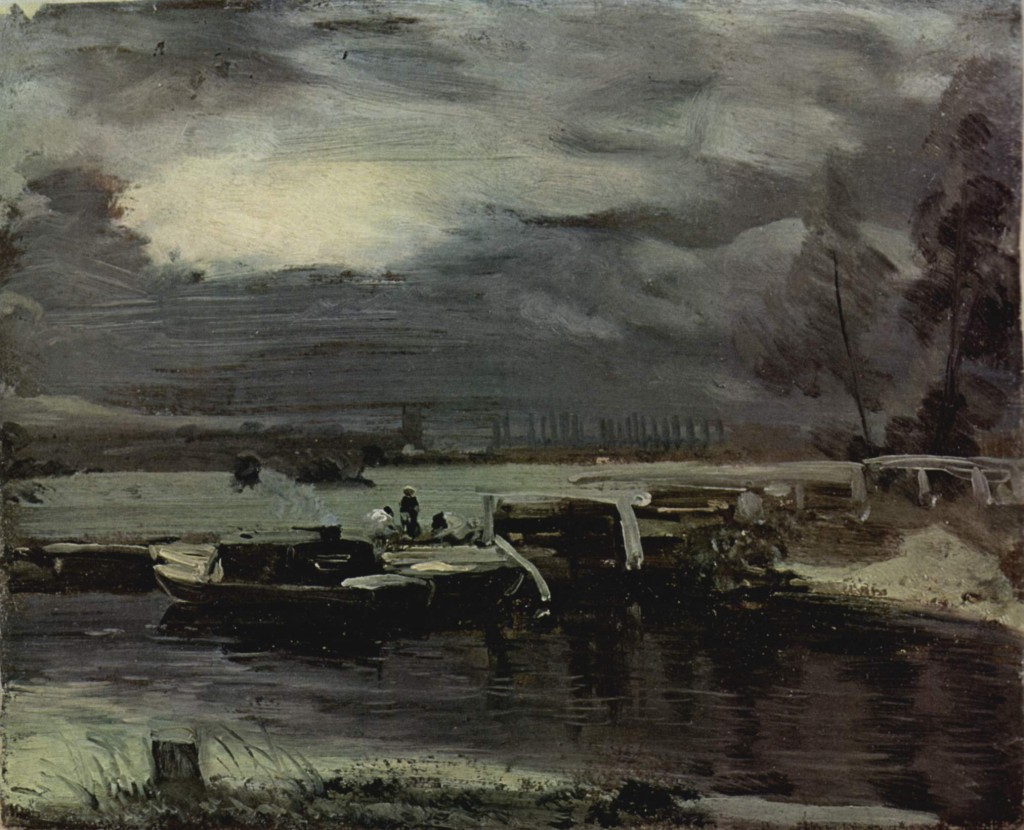
Barges on the Stour. 1811. Moments after a summer squall, Constable sketched a darkening sky over the river near his home in Suffolk. "The banks of the Stour...," he wrote,"made me a painter and I am grateful."
John Constable’s most explicit statement of his scientific approach to landscape painting was made in his last public lecture in 1836: “Painting is a science, and should be pursued as an inquiry in the laws of nature. Why, then, may not landscape painting be considered as a branch of natural philosophy, of which pictures are but the experiments?… In such an age as this, painting should be understood, not looked on with blind wonder, nor considered only as poetic aspiration, but as a pursuit, legitimate, scientific and mechanical.”
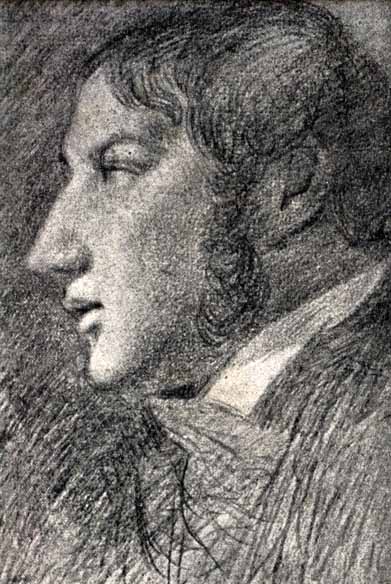
"Self-portrait 1806, pencil on paper, Tate Gallery London. Constable drew this profile, his only indisputable self-portrait, by an arrangement of mirrors."
John Constable sought to paint the skies and trees and, most of all, the light of England: an idea that shocked the art establishment of his time. …
Great artists are often seen as people who have been forced to struggle against enormous disadvantages in early life. John Constable is one artist who had no such struggle.
Born in Suffolk in June, 1776, the second son of Golding and Ann Constable; he was part of a prosperous family who owned a string of mills and were among the leading agricultural merchants in the river trade. The business was so successful by the 1770′s that Golding Constable was able to give up living in the hollow of Flatford Mill and build a “mansion house” in the village. The Stour villages were fine towns full of magnificent architecture from the days of the medieval wool merchants , and during John Constable’s boyhood they were being expanded by the Georgian gentry.
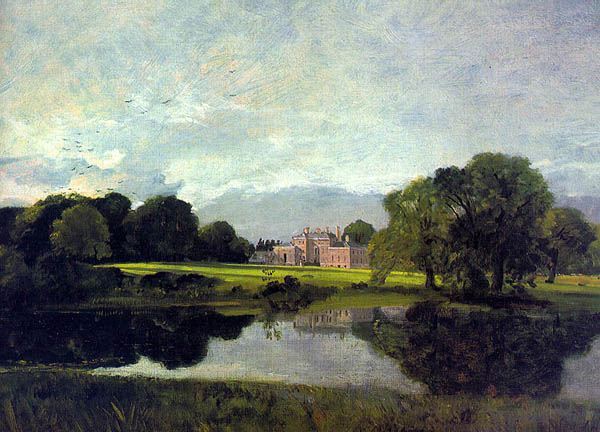
This view of Malvern Hall in Warwickshire, seen from raised ground across a stretch of water, recalls a long tradition of country house portraiture which goes back to the seventeenth century. Yet it appears to have been painted for Constable's own interest rather than being a formal, commissioned work. The sun is sinking below the trees to the left, which cast long shadows across the lawn at the back of the house. Above them hovers a flight of rooks. Many years later Constable wrote that the cawing of a rook was a 'voice which instantaneously placed?my youth before me'.
These crucial years of the eighteenth century, which the artist could barely recall but which molded the character of nearly all the people he knew, have been described by agricultural historians as the golden years of English farming. For John Constable, the essence of this glorious scene had ben set down in paint by Thomas Gainsborough.
There was to Constable, something overwhelming in the fact the Gainsborough had one walked the lanes that he now strolled in his slow, deliberate, country fashion. He saw Gainsborough “in every hedge and hollow tree” , and soon, scarcely daring to think about the consequences, he too was making up his mind to become an artist. “For long I foundered in the path and tottered on the threshold,” he wrote, “and there never was any young man nearer being lost than myself.”
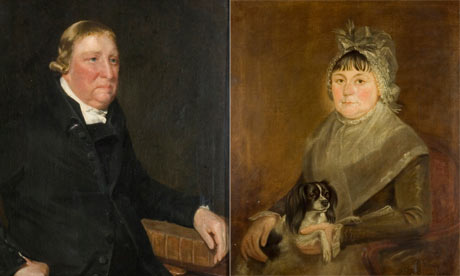
"Lyles and Gayford’s theory is based on Constable’s letters and family documents, which they pored over, analysing technique, and the fact that the canvas for the mother’s portrait came from a London artist’s supplier he is known to have used at that time. They believe the portraits date from around 1805, when Constable was 29 and a late starter still learning his trade. Like two tender tiny views of his parents’ fruit and vegetable gardens in Suffolk, they were among the pictures Constable kept with him all his life. “I imagine the father barely having the patience to sit for him, snapping ‘Oh get on with it!’ – while his mother was the one person prepared to pose for endless hours for him. She was absolutely devoted to him, her letters to him are full of worries about whether he has got the right clothes and enough to eat,” Lyles said."
This was certainly a boyish self-dramatization, for when we see what actually happened to John Constable; once he had convinced his practical East Anglian parents that neither the church not the flourishing family business was for him; we will find that he was shown “the path” by some of the most helpful guides anyone could wish for. What was even more extraordinary, these people were living, as it were, on his very doorstep.
Although his advantages were remarkable, John Constable, a man whose favorite word was “placid” , had been born into a world of violence and change. The American, French, and Industrial revolutions all occurred during his lifetime. And he himself, while seeking to prove the spiritual harmony of the natural universe, would be too revolutionary a painter to be understood.
But it was only where his painting was concerned that Constable was a revolutionary. In nearly every other way he was a conventional Tory gentleman who believed that the land is the source of all the best things in life, a God-given commodity that the landowners had to revere. The farmers worked for the landowners and the villagers worked for the farmers. It was all part of a divine pattern. His long and bitter struggle to be accepted as an artist by everyone, from the inhabitants of Suffolk to the members of the Royal Academy, was a wish to be an accepted part of the civilized world he so strongly believed in. His difficulties, and ultimate triumph, stemmed from his refusal to give the public what it wanted as the price for an easy entry into that world.
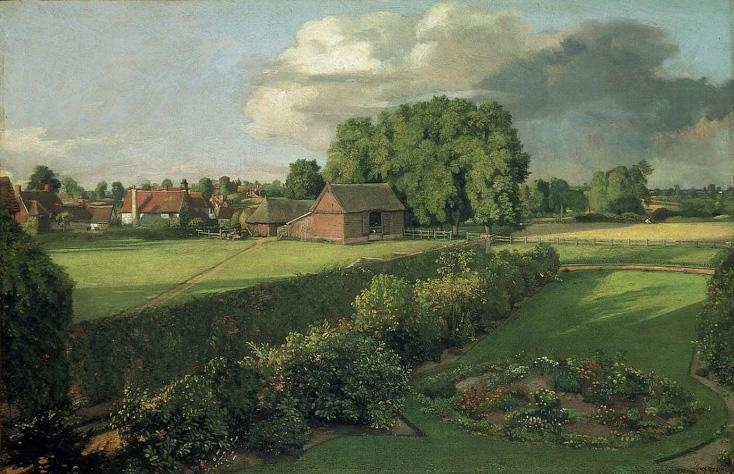
John Constable (1776 - 1837) Christchurch Mansion 1815 This sparkling landscape depicts the view from Constable's parental house in Suffolk; it was painted from an upper window or the roof. It depicts the flower garden belonging to the artist's father and it was conceived with the painting of the Flower garden as a panorama, moving from the village at the left of the flower garden to the refectory and houses at the right of the kitchen garden. Particularly remarkable are the pinpoint strokes of color that describe the flowers and foliage in the foreground, the luminosity of the fields and the sky, and the unusual angle of vision, which immediately reveals that this is an eye-witness account of the scene.
But the public did not want painting to be a science; they wanted painting to be a kind of magic. They did not want straightforward descriptions of the countryside they knew so well; they wanted stories and mystery in paint. They wanted to look into a picture as they could look into Virgil or into one of their favorite poems, “The Seasons” , and see an idealized existence. Constable bewildrered, and annoyed them, by leaving out these literary and emotional references and painting instead the natural realities of a certain place at a certain moment. This now seems a reasonable thing to do, but when Constable, at the very beginning of his career, confessed to his friend John Dunthorne, that he intended to be a “natural painter” , one of those rare peaks of total originality in art came into view.
Dunthorne was six years older than Constable and lived nearby in East Bergholt. He was one of those “odd men out” that so many villages produce, a plumber-glazier who was also an artist and freethinker. Constable was still a boy when Dunthorne taught him to grind colors and encouraged him to sketch. The association between the miller’s rather dandified son and the “atheist” as Dunthorne was called, was disapproved of in some quarters, though Golding Constable seems to have found it amusing. To him they were “Don Quixote and his Man Friday.”
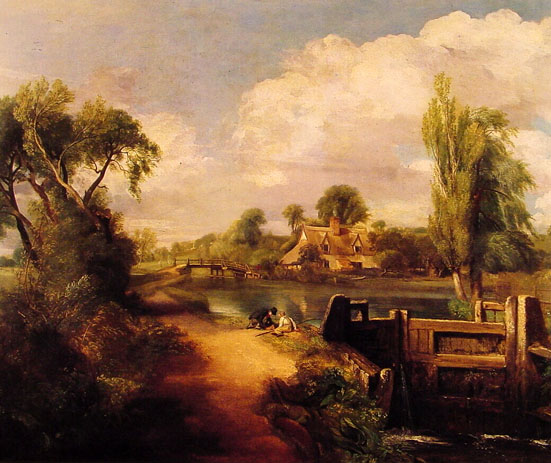
Landscape. Boys Fishing. 1813. In this view Constable depicted Flatford Lock on the River Stour upstream from the upper lock gate, with a wooden footbridge and Bridge Cottage beyond it, and Dedham Church in the distance. Two figures rest on the ground near the lock on a pleasant day. The scene was in the vicinity of that which Constable depicted in A boat passing a lock 1826. Lucas engraved the plate in 1831, basing it on the painting that Constable had exhibited at the Royal Academy in 1813 as Landscape: Boys Fishing. He made at least seven progress proof variations before the published state, of which this is the last. During the proofing the sky was reworked and the plants, birds and lights on the water were added. Heysen wrote: 'I feel elated at the inclusion of … A lock on the Stour - This always appeals as a well knit & most complete design'.
In 1796, when he was twenty, Constable met J.T. Smith, an antiquary who encouraged him to make drawings of old cottages in the Stour villages. These beautiful little pencil sketches were made in a book small enough to be held in the palm of the hand, and Constable acquired a habit that he would have for the rest of his life. William Blake was amazed by the perfection of these sketchbooks. “Why this is not drawing, but inspiration,” he told Constable. “I meant it for drawing,” replied Constable in the sharp way that was to unnerve so many of his fellow artists.
“But when he was sixteen, and it became clear his elder brother could not manage the family’s corn and coal trade, Constable reluctantly signed on. For several years he studied the business side of the Stour’s watermills, locks, barges, and towpaths. He sketched whenever he could. When he was 20 he met Sir George Beaumont, a painter and patron who would later establish the National Academy.
Paul Johnson describes how Constable fell in love with a landscape painting by Rubens –
Constable loved it so much that, when he stayed with Sir George, he was allowed to lug it into his bedroom so that it was the first thing he saw when he awoke in the morning. Beaumont reignited Constable’s passion for painting, but there seemed little Constable could do about it. At 22 he dejectedly faced the fact he was tied to his father’s business.”
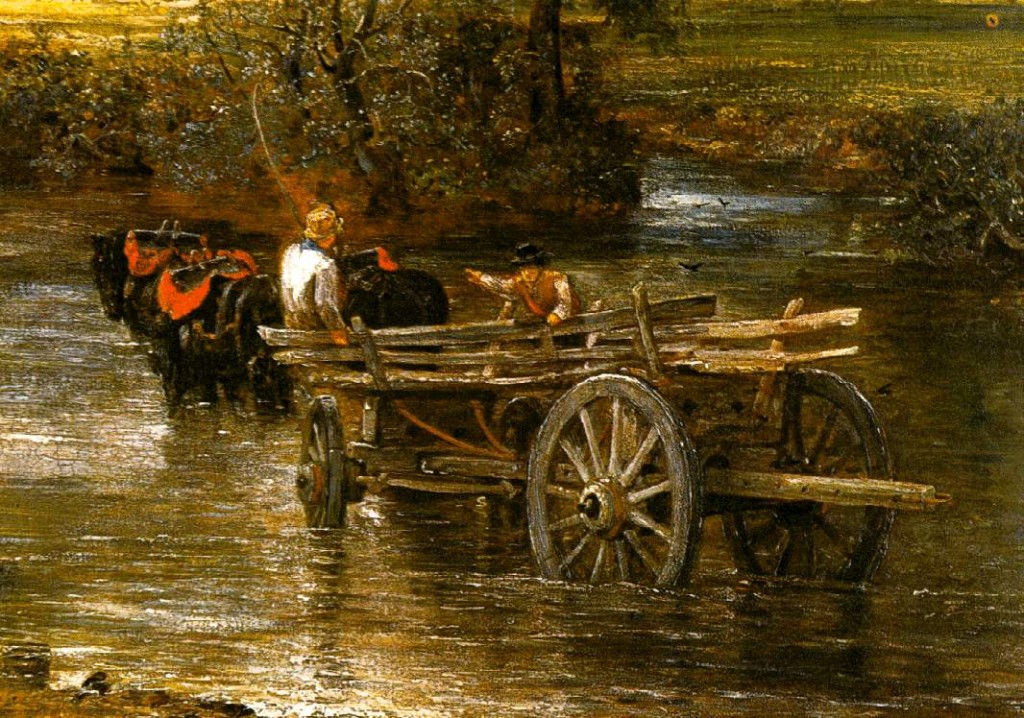
Constable. hay Wagon. "The work of Constable and Turner marks an important shift in the tradition of British landscape art. Although very different in style and content, the painting of Constable and Turner developed a freedom of paint handling that was to have a profound effect on landscape art. Constable’s preoccupation remained with physical actuality whilst Turner strove for the atmospheric. Together, however, they invented and explored the new language that French painters took up in the Barbizon school and then in Impressionism. The moods of nature, from the subtle range of greens in Constable’s meadows under windy, cloud-tossed skies to the greys, misty blues and browns of snow storms in Turner’s Alps or rain-lashed seas, feelings were expressed through a vocabulary of impasto paint and free brush strokes."
How far this good-looking, steely, and, at the same time, deeply spiritual youth had to go in order to persuade his parents to let him study painting is not known. But in 1799 he left Suffolk with an anuual allowance of one hundred pounds from his father and a student’s pass for the school set up by the Royal Academy. Three years later, in 1802, Constable returned to Suffolk, trained and expecting to earn a living.
His first step was to buy a Cottage studio away from his parent’s house ; his second to find some sort of answer to the barrage of criticism that now began to pursue him. Inevitably, the trouble started in his own family; with typical Suffolk common sense, they thought he should provide the neighborhood with what it required: namely portraits. Constable was willing to do them, but his rough impressionistic brushwork was an immediate cause for complaint. His rich uncle, David Watts, summed up the general feeling when he advised Constable to “Paint a little starling on your easel with the words, ‘Finish! Finish!’”.
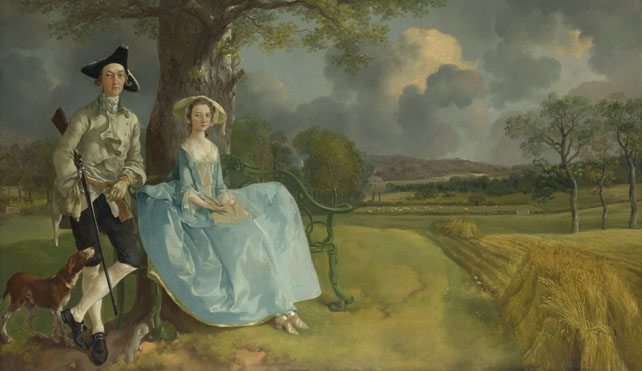
Gainsborough. Mr. and Mrs. Andrews. "The work of Constable and Turner owed a lot in the beginning to the 17th century landscape traditions of Europe. Constable was strongly influenced by the Dutch painters, like Hobbema and Jacob van Ruisdael, both directly and indirectly through the landscapes of Thomas Gainsborough. Gainsborough’s “Mr and Mrs Andrews” is a key work here, its rolling countryside backdrop alerting Constable to the picturesque potential of his Suffolk homeland. "
One neighbor, a Mr. Reade, did commission a painting of his house, and “Old Hall” was the first of what Constable called his “house portraits,” the most superb of which is “Malvern Hall” , painted in 1810. Constable asked ten guineas for “Old Hall” ; with “Malvern Hall” he would ask the world to see a new vision of art.
But in 1802 it was still Thomas Gainsborough and the old vision that enthralled him, and his great problem was reconciling the traditional landscape, which in many ways he admired and respected, with the “natural truths” he saw whenever he glanced out the window at Flatford Mill or looked across the water meadows to Dedham. One thing he never worried about was finding a subject. His home valley, a six mile stretch of East Anglian river scenery with church towers, huge trees, industrial buildings, and brilliant light, was an incomparable challenge.
Later he would say he never wanted to paint any scene where he was not a “welcome guest” And, when the time came for him to show people what kind of artist he intended to be, he would choose the valley he knew so well as the subject for his first big picture.
“Constable painted a few portraits, but stubbornly turned down a job teaching drawing at a military school. “It would have been a death blow to all my prospects of perfection in the Art I love,” he wrote a friend (Oxford Dictionary of National Biography). After ten years, his parents were increasingly worried. He had exhibited at the Royal Academy. He was exploring interesting techniques, but he had not been accepted as an associate of the Academy and he was not earning a living. About this time he fell in love.
He was thirty-three. Maria Bicknell was twenty-one. Her family was implacably opposed to their marriage. Constable’s mother advised him to pursue his goals with Christian fortitude, patience, and diligence, and for heaven’s sake earn the money he needed to get married.”
These two artists ( Constable and Turner ) mark the boundaries between classicism and topography in landscape and the move toward Romanticism. Their work must be set against, or be seen to respond to, the social and political changes which the Industrial Revolution was bringing about across Europe. Other art forms beside painting – writing, poetry, music – were adopting a different, more romantic view of the landscape. As Wordsworth wrote so Constable and Turner felt, “one impulse from a vernal wood can teach us more of man, of moral, evil and of good, than all the sages can”.
a
